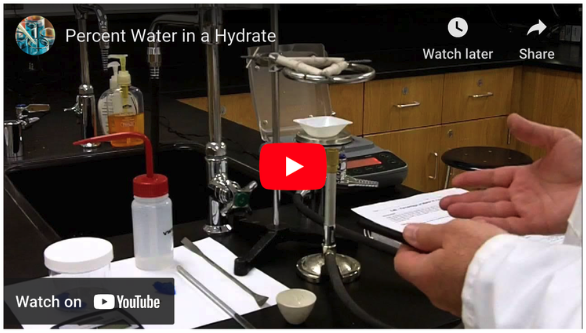Determine the Formula of a Hydrate
🔒 LAB RESOURCES:
Student Procedure [PDF] [DOC]
Teacher Annotated Procedure [PDF]
Complete Lab Guide [HERE]
GoogleSheet Data & Analysis [HERE]
SUMMARY/ OVERVIEW:
Heating a hydrate removes water, leaving the anhydrous compound. By measuring the mass difference, the moles of water lost can be calculated and compared to the moles of anhydrous compound to determine the hydrate's formula.
ESTIMATE TIME ⏰: 40-60 minutes
Multiple heating and cooling cycles until dehydrated (20 minutes)
Cooling crucible before each weighing (10 minutes each time)
SAFETY PRECAUTIONS:
Background Information
Many ionic compounds naturally contain water molecules as part of the crystal lattice structure. A hydrate is a compound that has one or more water molecules bound to each formula unit. Several examples include sodium carbonate decahydrate (Na2CO3 •10H2O), also known as washing soda; magnesium sulfate heptahydrate (MgSO4 •7H2O), commonly called Epsom salt; and calcium sulfate dihydrate (CaSO4 • 2H2O), which is known as gypsum. Another common hydrate is copper(II) sulfate pentahydrate, which contains 5 moles of water per 1 mol of copper(II) sulfate, written as CuSO4 •5H2O
Ionic compounds that contain a transition metal are often highly colored. Interestingly, it is common for the hydrated form of a compound to be of a different color than the anhydrous form, which has no water in its structure. A hydrate can usually be converted to the anhydrous compound by heating. For example, the anhydrous compound cobalt(II) chloride is blue, while the hydrate is a distinctive magenta color (as seen below).
The hydrated form of cobalt(II) chloride contains six water molecules in each formula unit. The name of the compound is cobalt(II) chloride hexahydrate and its formula is CoCl2 • 6H2O. The formula for water is set apart at the end of the formula with a dot (•), followed by a coefficient that represents the number of water molecules per formula unit. These water molecules are part of the structure and hydrated chemical, therefore cannot be changed when balancing a chemical equation.
In a hydrate, water molecules are distinct parts of the compound but are joined to it by bonds that are weaker than either those forming the anhydrous salt (without water) or those forming the water molecules. Hydrates can usually be converted to the anhydrous form by heating:
Hydrated salt → anhydrous salt + water
*Usually a triangle is written above the arrow, to indicate heating.
If water is added to anhydrous substances, the color returns indicating that the hydrate has been regenerated. True hydrates display this property of reversibility. Other compounds that react when heated to produce water are not hydrates if they are unable to reabsorb the water they have lost.
Additional information for the curious
Some hydrates such as CoCl2 lose water to the air in a process called efflorescence. There hydrates can absorb water from the air or other sources so strongly that they can be used to dry liquids or gases. These substances are called desiccants, and are said to hygroscopic. Some compounds, such as NaOH, can take up so much water from the air that they dissolve the water they absorb. This process is called deliquence.
Use of a Desiccator
A desiccator is an airtight container which maintains an atmosphere of low humidity through the use of a suitable drying agent which occupies the bottom part of the desiccator. It is used both for the cooling of heated objects and for the storage of dry objects that must not be exposed to the moisture normally present in the atmosphere.
This lab does NOT use a desiccator. It is OPTIONAL. View more on using a desiccator here.
Experimental Set-up
The following video provides the concept of the lab.
Please take note of the following things which you should NOT do as demonstrated in the video:
The copper(II) sulfate used may look different initially (not a large blue crystal). It might not be as deep blue (but it is still blue).
try NOT to poke around with a glass stirring rod. Every time you touch your compound some may be lost to the stirring rod, impacting your results.




